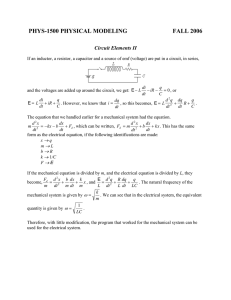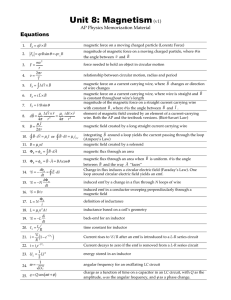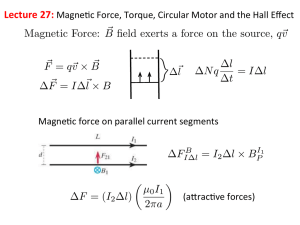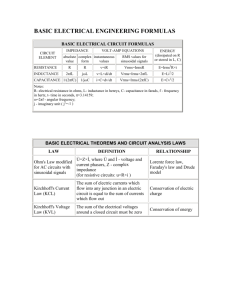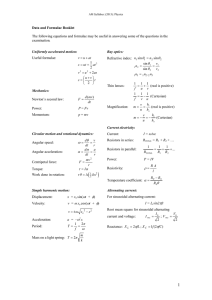simulation of the electromagnetic solenoid using matlab simulink
advertisement
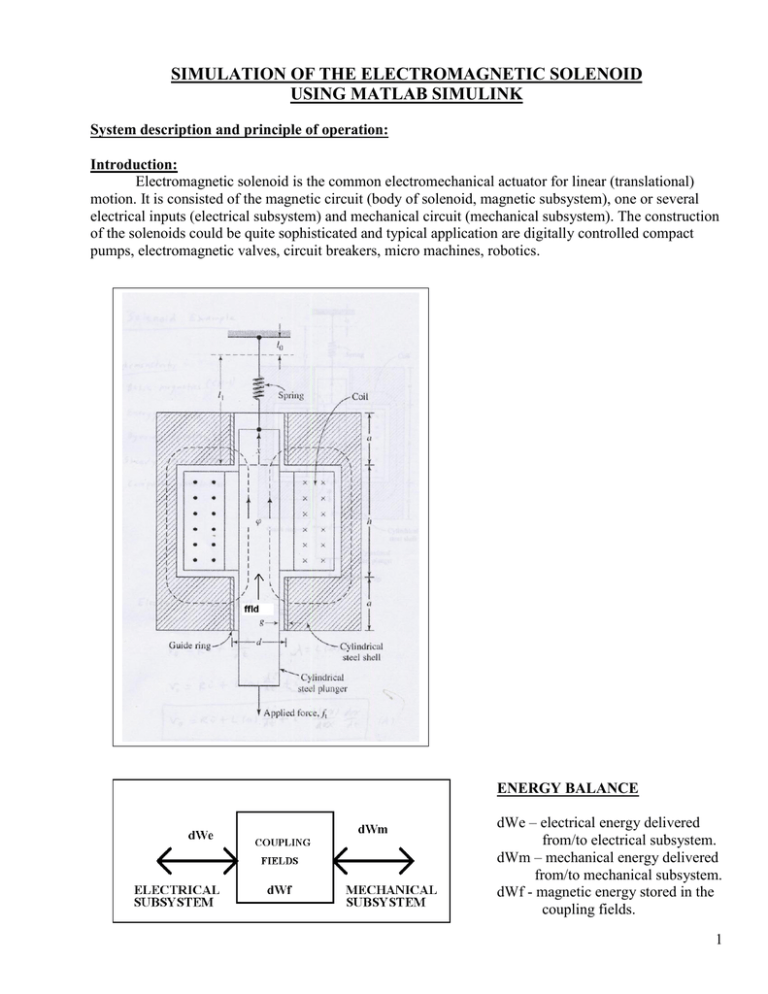
SIMULATION OF THE ELECTROMAGNETIC SOLENOID USING MATLAB SIMULINK System description and principle of operation: Introduction: Electromagnetic solenoid is the common electromechanical actuator for linear (translational) motion. It is consisted of the magnetic circuit (body of solenoid, magnetic subsystem), one or several electrical inputs (electrical subsystem) and mechanical circuit (mechanical subsystem). The construction of the solenoids could be quite sophisticated and typical application are digitally controlled compact pumps, electromagnetic valves, circuit breakers, micro machines, robotics. ENERGY BALANCE dWe – electrical energy delivered from/to electrical subsystem. dWm – mechanical energy delivered from/to mechanical subsystem. dWf - magnetic energy stored in the coupling fields. 1 In a cylindrical ferromagnetic steel shell a cylindrical movable steel plunger has been placed. The plunger is connected to spring. Inside the shell, a coil is connected to DC voltage source. As a result of energizing coil, the electric energy will be transferred to magnetic field energy. The electromagnetic force will move plunger in a positive direction of coordinate (x) and decrease the reluctance of the magnetic circuit (increase inductance). At the end of this process, electromagnetic force will be equal to spring force. If we suddenly apply external mechanical force fo and move plunger, it will decrease inductance and magnetic energy of the coupling filed will be transferred to mechanical energy of the spring. When electromagnetic force equals restraining force, new operation point will be established. When mechanical force fo drops to zero, system will go back to starting operation point and mechanical energy of the spring will be transferred to coupling field. Part of energy will be dissipated in the electric circuit during transients and due to friction losses. Mathematical model Electrical subsystem is described by 2nd KVL, assuming magnetically linear system: d ; dt L ( x ) i; v0 R i di dL( x) dx i ; dt dx dt di 1 dL( x) dx v 0 R i i ; dt L( x) dx dt v0 R i L( x) (1) Mechanical subsystem is defined by second Newton’s law: dv d 2x M 2; dt dt dx d 2x f fld K ( x x0 ) B f 0 M 2 ; dt dt 2 d x 1 dx f fld B K ( x x0 ) f 0 ; 2 M dt dt F M a M (2) Inductance could be derived knowing reluctance of the system: RM g g g a x ; 0 x d 0 a d 0 a d x L( x) L' N 2 0 a d N 2 RM g 0 a d N 2 g x x L' ; a x a x (3) ; 2 The electromagnetic force could be derived knowing that magnetic system is linear and that current was kept constant during change of operation point. dWf i 2 dL( x) i 2 a L' f fld ; dx 2 dx 2 (a x) 2 dL(x) a L' ; where L' 23.69 mH; dx (a x) 2 (4) Block diagram 3 Instructions : In general, inputs of the multiplexer are marked using following notation: u(1) = i; u(2) = x u(3) = dx/dt Function blocks could contain complex functions. Put these expressions in the following function blocks. Ffld – electromagnetic force [((i^2)/2)*dL/dx] ((0.01*0.02369)/2)*(u(1)^2)/((0.01+u(2))^2) Bemf- back-electromotive force [ i*dL/dx * dx/dt] u(1)*u(3)*(0.01)*(0.02369)/(((0.01)+u(2))^2) The inductance of the system was calculated using function block : L(x) – inductance of the system (0.02369*u(1))/(0.01+u(1)) Set external inputs to system: Open input voltage block v0 and set Step time=0.1, Initial value=0, Final value=5. Open external force block f0 ON and set Step time=0.4 , Initial value=0, Final value=10 Open input voltage block f0 OFF and set Step time=0.7, Initial value=0, Final value=10. Set initial condition for integrator 2: Open integrator 2 and set initial value to 0.002. All other integrator should have initial value 0.0. Set simulation parameters: Start time: 0.0 Stop time: 1.0 Type: Fixed step Solver: Ode4 (Runge-Kutta) Periodic sample time constraint: Unconstrained Fixed step size: 1e-4. 4 Simulation results: 5
